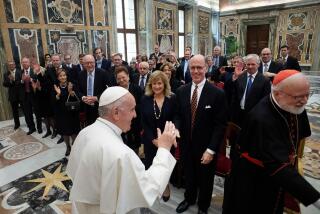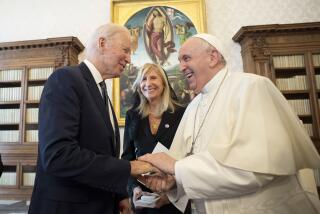As Pope’s Health Ebbs, Church Enters a Season of Uncertainty
VATICAN CITY — The pope is alert. He responds to what he’s being told. He looks much better.
The pope seems weak and vacant. He doesn’t acknowledge what he’s being told. He looks much worse.
Both assessments of the pope’s condition are offered by visitors to John Paul II these days, and both are accurate. Depending on the moment, on whether he has rested and how his medicine is working, he can remain attentive and engaged. Or he can seem worryingly frail.
As the Vatican prepares for a high-profile ceremonial season with the pope’s health in question, the world’s largest and most powerful Christian institution faces an uncertain period in which top prelates are jockeying for position to influence both the church’s direction and the pope’s succession; public policy seems adrift or incongruous; and it is not at all clear who’s in charge.
What is clear is that the 83-year-old pope is unwell. As the world saw during October celebrations marking the 25th anniversary of his election, the pope no longer walks and hardly talks. In public, he speaks less and less.
As he fades, other priests are, by all accounts, stepping in to fill the widening voids, and John Paul’s role in day-to-day affairs is minimal.
Afflicted by Parkinson’s disease and numerous other ailments, he has little energy to stand up to the competing factions within the Vatican, observers say.
“Clearly, he is an old man. Clearly, he is a sick man. Increasingly, his responsibilities are being delegated to others, and he is not able to sustain his old schedule,” said the Rev. Keith Pecklers, a Jesuit theologian at the Pontifical Gregorian University in Rome.
The Polish pontiff was always one to delegate, never too concerned with the nuts and bolts of running a bureaucracy that parallels the White House or the Kremlin.
But there is ample evidence that John Paul’s range of activities is diminishing.
Fewer people are granted access to him. Those who do get it are allowed less time.
The pope’s upcoming Christmas schedule has been curtailed -- for the first time in a quarter-century, he will not name a new group of bishops Jan. 6, the Feast of the Epiphany, or baptize children in the Sistine Chapel a week later.
Once in a while, however, there are signs of his personal touch. John Paul’s homilies occasionally contain references that only he would make. Last month, he scolded former Polish President Lech Walesa for taking the Solidarity labor union, which the pope once championed, into partisan politics.
When he chose 31 new cardinals in September, among them were men who were not particularly well known in wider church circles but who had played important roles in John Paul’s life.
And he still signs off on the nominations of bishops. “We can tell it’s his handwriting because the lines are so shaky,” said one Vatican insider.
But he knows less about the men he is approving and relies more and more on deputies to make the decisions. “They put it on his desk and he signs,” another church official said.
Despite John Paul’s penchant for centralizing church authority during the last 25 years, the structure of the Vatican is such that its many divisions, known as congregations and dicasteries, function with quite a bit of autonomy. Much of the church’s activities grind on, whether or not the pope is involved. The worry of some Roman Catholics, however, is that the bold initiatives that were once the hallmark of this papacy have disappeared.
Joaquin Navarro-Valls, the chief Vatican spokesman, denied that its institution is adrift. He said the pope’s will continues to be executed, whether or not he personally conveys it, because his aides can anticipate and project his thoughts.
“His goals and ideas are there. They are impregnated in his collaborators,” Navarro-Valls said. “Even though the physical energy is declining, what is coming out of the Holy See is John Paul II. It is his thinking. His intellectual product is so large that even after [his death], that body of ideas will be very much present.”
Increasingly, however, ambitious prelates in the Roman Curia, or the Vatican administration, are carving out turf for themselves, and hard-line conservatives are plainly gaining ground, experts say.
The two most powerful men closest to the pope are Cardinal Angelo Sodano, the Vatican’s secretary of state, and John Paul’s personal secretary, Archbishop Stanislaw Dziwisz, a fellow Pole who is the gatekeeper to the papal inner sanctum.
Dziwisz is always seen at the pope’s side, sleeps in a room off of the pope’s apartment and is remembered famously as the man cradling John Paul’s head moments after a would-be assassin shot him 22 years ago.
By all accounts, it is Dziwisz who decides who sees and does not see the pope, and it is he who relays the pope’s decisions to others in the Curia. The joke around the Vatican is that the second Polish pontificate has commenced. Some observers believe that if Dziwisz makes decisions on his own, as is suspected, he does so only in keeping with what he knows, or thinks, the pope would want.
John Paul promoted his loyal aide to archbishop in October. Among the new cardinals, one was named “in pectore,” or secretly, and there is speculation that this might be Dziwisz. (If Dziwisz were to become a cardinal and it was made public, he could no longer serve as the pope’s secretary.)
Vatican insiders debate whether Dziwisz or Sodano has more real power.
Formally, Sodano is the No. 2 person in the church, after John Paul. He is the consummate bureaucrat, and as such complements a big-picture pope.
While he is often mentioned as a papabile -- potential pope -- Sodano lacks pastoral experience and, say some people who know him, the gravitas to succeed John Paul. But he does seem to be positioning himself as a kingmaker.
By tradition, Sodano should have retired as secretary of state because he turned 75 last year. But he and another key, aging prelate, Cardinal Joseph Ratzinger, 76, have kept their seats next to the pope, according to new Curia appointments released last week.
The two are among the ever-smaller number of people who meet regularly with John Paul, and both have overseen promotions for their closest aides in recent weeks.
Ratzinger, a German, is the very conservative watchdog of Catholic dogma, a role he has filled for 22 years as prefect of the Congregation for the Doctrine of the Faith.
Analysts say that maintaining Sodano and Ratzinger beyond retirement age signals the Vatican’s acknowledgment that the pope’s time is running out. Naming a new secretary of state at this late date would oblige the next pope to keep him on when he might prefer his own deputy.
As those closest to the pope consolidate their hold on power, there have been a number of recent signs that the most conservative members of the inner circle are winning.
* Ratzinger lashed out at Islam last week, criticizing what he called its tendency to mix politics and religion. He echoed a blistering commentary in the Civilta Cattolica, a Jesuit magazine published only with the approval of Sodano’s Secretariat of State. The magazine said Islam has forever “shown a warrior and conquering face” that constantly threatens Europe.
The criticism came despite the pope’s well-known strides in opening dialogue with Muslim clerics and promoting interfaith relations. In the latest group of cardinals, the pope’s preeminent envoy to Islam, Archbishop Michael Fitzgerald, was omitted, contradicting many a prediction.
* Two senior prelates close to the pope who, like him, strongly opposed the war in Iraq have been sidelined. Cardinal Renato Martino was replaced as the Vatican’s permanent representative to the United Nations, and the highly regarded Jean-Louis Tauran, just named cardinal, was removed as foreign minister of the Holy See and relegated to the post of librarian of the Vatican archives.
By contrast, Cardinal Camillo Ruini, the bishop of Rome, surprised many Vatican watchers by failing to use the funeral Mass of 19 Italians killed in Iraq as a platform for criticizing the war.
“No more Third World rhetoric, no more pacifist homilies -- no more discordant voices,” Sandro Magister, a veteran writer on the Vatican, noted in Thursday’s issue of L’Espresso magazine.
* After years of wrangling, the Vatican has prevailed in insisting that the Roman Missal, the book of prayers used in the Mass, will be translated into English in a way that cleaves more closely to the Latin, in contrast to the desires of many U.S. bishops and others. “Homines,” for example, will be translated as “men” instead of a more inclusive term.
“No one doubts that liturgical language must be appropriately formal,” the Tablet, a London-based Catholic weekly, said in a critical Nov. 1 editorial, “but the risk is that the result will bypass or alienate Catholics in the English-speaking world at a time when lay involvement in liturgy is more than ever necessary.”
Today, the pope cannot perform many liturgical functions -- he rarely says Mass and cannot complete his homilies -- or travel the way he used to, meaning he can no longer evangelize.
Bishops are required to make visits to the pope every five years to update him on their diocese. Traditionally, each prelate had 20 one-on-one minutes to describe what was happening in the troubled, thriving congregations of Africa, or the threatened but vibrant villages of Central America.
But starting in November, the visit has been slashed to three or five minutes. Instead of informing the pope of their problems and giving him the knowledge needed to govern their areas and decide on their leaders and policies, bishops give formalistic salutations.
“If your time [with the pope] is cut to three or five minutes, it’s nothing more than a courtesy visit,” Pecklers said. “The pope cannot be on top of it.”
And so the Vatican waits.
It’s like many lame-duck administrations -- the difference here is that no one knows how long the period of limbo will last.
More to Read
Sign up for Essential California
The most important California stories and recommendations in your inbox every morning.
You may occasionally receive promotional content from the Los Angeles Times.











